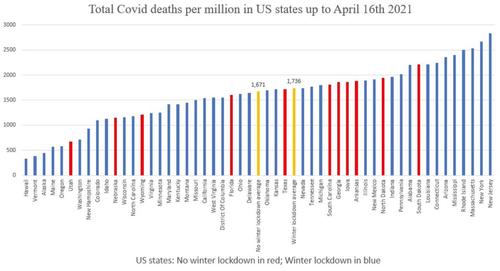One of the great things about America is that it has 50 states that can set their own policy across a broad range of areas, including on public health and lockdowns. This has allowed some to resist the stampede to impose swingeing restrictions on normal life in the hope of limiting transmission of SARS-CoV-2, and this provides us with a valuable control group in the great lockdown experiment that can give us an idea what might have happened if we hadn’t made some intervention or other.
During the autumn and winter a new surge in Covid infections prompted most US states, like most Western countries, to reimpose restrictions. But a few resisted. Eleven states did not impose a stay-at-home order and left people at liberty to leave their homes whenever they wished. Of these, four – Florida, Georgia, South Carolina and South Dakota – did not impose any restrictions at all and treated it pretty much like any other winter.
In the chart above I have used data from Worldometer to plot the current total Covid deaths per million for each state. I have coloured the 11 states which did not lock down (i.e., impose a stay-at-home order) this winter in red. I have also calculated the average for the two groups of states, those which did not lock down over the winter and those which did, and coloured them in yellow.
As you can see, states which did not lock down over the winter, far from having many times more Covid deaths, have actually had fewer – 1,671 vs 1,736 deaths per million. There may be demographic or other reasons that some states have a higher or lower number of deaths than others so we shouldn’t read too much into the precise differences. But even so, if lockdowns are supposed to suppress the virus to low levels and thus prevent ‘hundreds of thousands’ of deaths (or the population equivalent), then how is this possible? The only conclusion is that lockdowns do not work as intended and do not suppress the virus.

No comments:
Post a Comment